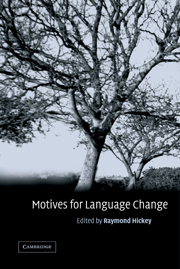Book contents
- Frontmatter
- Contents
- Notes on the contributors
- Acknowledgements
- Introduction
- Part I The phenomenon of language change
- Part II Linguistic models and language change
- Part III Grammaticalisation
- Part IV The social context for language change
- 9 On the role of the speaker in language change
- Part V Contact-based explanations
- Part VI The typological perspective
- Index
- References
9 - On the role of the speaker in language change
Published online by Cambridge University Press: 22 September 2009
- Frontmatter
- Contents
- Notes on the contributors
- Acknowledgements
- Introduction
- Part I The phenomenon of language change
- Part II Linguistic models and language change
- Part III Grammaticalisation
- Part IV The social context for language change
- 9 On the role of the speaker in language change
- Part V Contact-based explanations
- Part VI The typological perspective
- Index
- References
Summary
Introduction: internal and external factors in change
It is true, I think, that in what might be called the dominant tradition in historical linguistics, it has been assumed that languages change within themselves as part of their nature as languages. The ‘external’ agency of speaker/listeners and the influence of ‘society’ in language change have tended to be seen as secondary and, sometimes, as not relevant at all. Roger Lass has been a prominent, but balanced, defender of the traditional view. He has correctly pointed out (1980: 120) that in the tradition, it has been assumed that it is languages that change and not (necessarily) speakers who change languages. More recently (1990: 370), he has commented that language change is not something that speakers ‘do’ to their language, and that ‘endogenous change is part of the nature of the beast’ (1997: 208). He has also (largely correctly) suggested in various publications that speaker-based explanations have been unsatisfactory because of the attribution to speakers of qualities that they may not actually have. In some such accounts the speakers appealed to are disembodied abstractions who can be made to ‘do’ almost anything the researcher wants them to. Much more generally, however, the idea of endogenous or internally triggered change is so deeply embedded in our subject that it feeds into what can be called the discourse of historical linguistics. In this discourse, individual languages are typically presented as changing within themselves rather than being changed through the agency of speaker/ listeners.
- Type
- Chapter
- Information
- Motives for Language Change , pp. 143 - 158Publisher: Cambridge University PressPrint publication year: 2003
References
- 8
- Cited by



